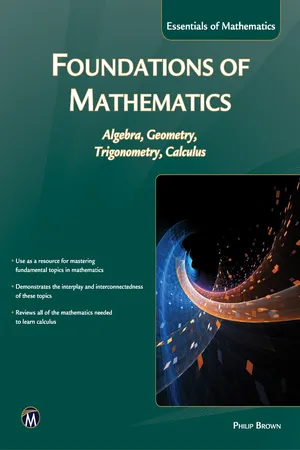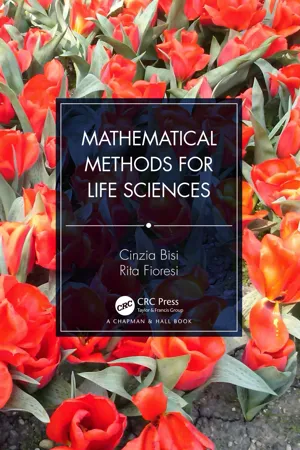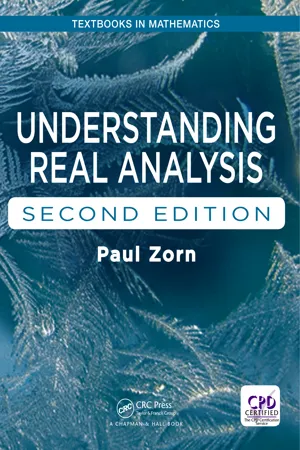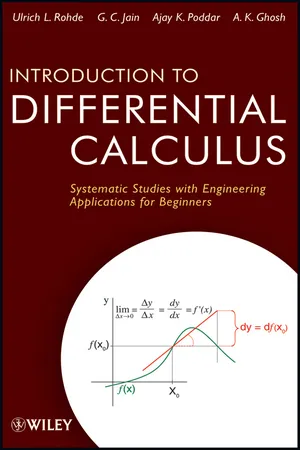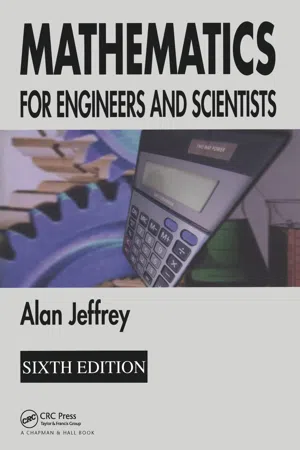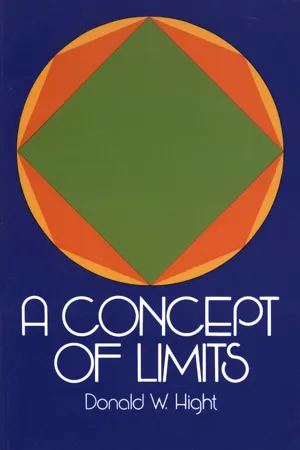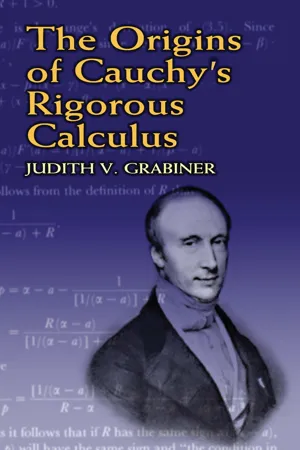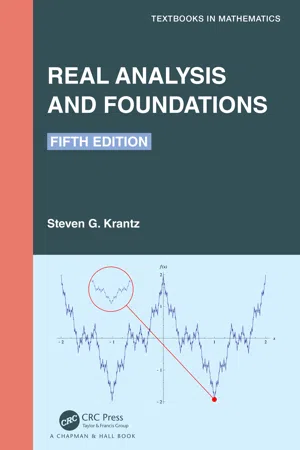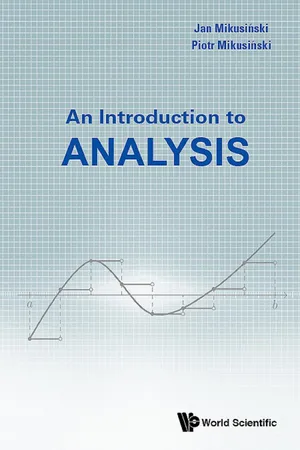Mathematics
Limits
In mathematics, a limit is a fundamental concept used to describe the behavior of a function as it approaches a certain value. It represents the value that a function approaches as the input approaches a specific point. Limits are essential for understanding continuity, derivatives, and integrals in calculus.
Written by Perlego with AI-assistance
Related key terms
Related key terms
1 of 4
Related key terms
1 of 3
10 Key excerpts on "Limits"
- eBook - ePub
Foundations of Mathematics
Algebra, Geometry, Trigonometry and Calculus
- Philip Brown(Author)
- 2016(Publication Date)
- Mercury Learning and Information(Publisher)
7Limits
7.1INTRODUCTION
The concept of a limiting value of a function plays an important role in calculus, because the formal definition of the derivative of a function at a point in its domain can be expressed as the limiting value of a particular expression involving the function.The meaning of “limit” in mathematics is more subtle than that in everyday speech. A speed limit that applies on a highway is a speed that motorists may not exceed. The meaning of “limit” in mathematics is similar to that in the following sentence: “In the minute to win it competition the contestant was pushed to the limit of his abilities.” Thus, a “limit” in mathematics is something (like a number or geometrical figure) that is approached and might or might not be reached.It is in keeping with the historical approach of this book to begin with the method of exhaustion as an example of an occurrence of a limit in mathematics, as this is the method that Archimedes and other Greek mathematicians of his time used to calculate approximate values of certain areas, for example, the area of a disk. In section 7.3 , the concept of a limit is explained carefully using number sequences without giving the completely rigorous treatment (involving ε arguments) that are given in more advanced textbooks. Students of this book will probably not benefit from such a theoretical approach at this stage.The notion of the left or right limit of a function, introduced simplistically (by reading from a graph) in section 7.4 , leads to the definition of continuity of a function in section 7.5 . The property of continuity is important because many theorems about functions, for example, the Intermediate Value Theorem (in section 7.7 ), apply only to functions that are continuous.Most of the skills that students need to learn in this chapter are introduced in sections 7.6 and 7.8 - eBook - ePub
- Cinzia Bisi, Rita Fioresi(Authors)
- 2024(Publication Date)
- Chapman and Hall/CRC(Publisher)
2 Limits and DerivativesDOI: 10.1201/9781003343288-22.1 Limits
The concept of limit represents the foundation of differential and integral calculus: it tells us how the value f(x) of a function f changes as the variable x approaches a value x0 .For example, consider the linear function f(x) = x + 3. We see that f(x) approximates the number 5, as x approaches the value x0 = 2. We can easily see it, if we substitute the value 2 for x: f(2) = 2 + 3 = 5 and we look at the graph of the line y = x + 3. Indeed, for values of x close to the point x0 = 2 on the x-axis, the corresponding values of the function f are very close to f(2) = 5.x f(x) 2 5 2.1 5.1 1.9 4.9 As we shall see, we need the definition of limit to understand the values of the function f at x “near” x0 , when we cannot evaluate the function f at x0 .Definition 2.1.1 Let f : D → ℝ and suppose that f is defined at all points of an open interval containing x0 , but not necessarily in x0 . We say that the real number L is the limit of f(x) for x approaching x0 , if, for every ε > 0, there exists δ > 0 such that, if 0 < |x − x0 | < δ, we have:| f ( x ) − L | < ϵWe write in formulas:limf ( x ) = Lx →x 0Let us see an example.Example 2.1.2 We want to check that the limit of the function f(x) = x + 3, for x approaching 2, is equal to 5, as we intuitively anticipated at the beginning of this section:limx + 3 = 5x → 2We must show that, for any number ε > 0, we can always find a number δ > 0, such that if 0 < |x − 2| < δ, then |x + 3 − 5| < ε. Let us start by examining the last inequality:| x − 2 | < ϵ ⇔ 2 − ϵ < x < 2 + ϵSo if δ = ε, we have 0 < |x − 2| < δ.We invite the reader to check by exercise, using the reasoning of the previous example, that:(2.1)limx =x →x 0x 0,limk = kx →x 0where k ∈ ℝ is a constant.We can also define the right-hand limit and the left-hand limit of a function at x0 .- Right-hand limit: We define lim x
- eBook - ePub
- Paul Zorn(Author)
- 2017(Publication Date)
- Chapman and Hall/CRC(Publisher)
CHAPTER 3Limits and Continuity
3.1 Limits of FunctionsThis chapter is about continuous functions and their properties. As a foretaste, consider this reasonable‐sounding claim about a function f :If f ( - 1) = - 2 and f (1) = 5, then f (a ) = 0 for some a ∊ ( - 1, 1) .Is this true? If a graph passes through the pointsand( - 1 , - 2 ), must it also cross the x -axis somewhere in between? Must there also be an input b with f (b ) = π ?( 1 , 5 )Both answers turn out to be “yes”—if the function f is continuous everywhere along the input interval [−1, 1]. In this case, answers follow from the famous intermediate value theorem , which we will carefully state and prove later in this chapter. To prove such results we’ll draw on earlier work with completeness, suprema and infima, Limits, the Bolzano–Weierstrass theorem, and more. Our work starts, as usual, with clear definitions of words like “limit” (as applied to functions) and “continuous.”The IV theorem says that the range of a continuous function has no “gaps”; details come later.Defining Limits of Functions
Most of us emerge from elementary calculus courses with a rough and ready view of function Limits. To say that limx →3f (x ) = 5, for example, means something like f (x ) approaches 5 as x approaches 3, or f (x ) ≈ 5 when x ≈ 3.These views are not incorrect, but they are too vague to be useful for building theory or proving theorems. What exactly does “approaches” mean? How close to 3 must x be for x ≈ 3 to hold? We need a precise definition.Definition 3.1 (Limit of a function). Let f be a function whose domain includes an open interval I containing a , except perhaps for x = a . Let L be a number. We writeObserve, right away, two important subtleties about domains:if, for every ɛ > 0, there exists δ > 0 such that |f (x ) - L | < ɛ whenever x ∊ I and 0 < |x - a | < δ .limf( x )= L• At x = a : The value f (a ) itself need not be defined for the limit to exist at x = a . Indeed, the whole point of finding such a limit is often to do with a “missing” or mysterious function value. If f (a ) is defined, that’s fine, but it’s irrelevant to the definition, which avoids all mention of f (a - eBook - ePub
Introduction to Differential Calculus
Systematic Studies with Engineering Applications for Beginners
- Ulrich L. Rohde, G. C. Jain, Ajay K. Poddar, A. K. Ghosh(Authors)
- 2012(Publication Date)
- Wiley(Publisher)
Chapter 7a The Concept of Limit of a Function 7a.1 IntroductionAddition, subtraction, multiplication, division, raising to a power, extracting a root, taking a logarithm, or a modulus are operations of elementary mathematics. In order to pass from elementary mathematics to higher mathematics, we must add to this list one more mathematical operation, namely, “finding the limit of a function ”.The notion of limit is an important new idea that lies at the foundation of Calculus. In fact, we might define Calculus as the study of Limits. It is, therefore, important that we have a deep understanding of this concept. Although the topic of limit is rather theoretical in nature, we shall try to represent it in a very simple and concrete way.7a.2 Useful Notations Our work for understanding the concept of limit will be simplified if we use certain notations. Therefore, let us first get familiar with these notations:- Meaning of the notation x → a:
Let x be a variable and “a ” be a constant. If x assumes values nearer and nearer to “a ” (without assuming the value “a ” itself), then we say x tends to a (or x approaches a ) and we write x → a . In other words, the procedure of giving values to x (from the domain of “f ”) nearer and nearer to “a ”, but not permitting x to assume the value “a ”, is denoted by the symbol “x → a ”.Thus, x → 1 means, we assign values to x which are nearer and nearer to 1 (but not permitting x to assume the value 1), which means that x comes closer and closer to “1”, reducing the distance between “x ” and “1”, in the process.Thus, by the statement “x ” tends to “a ”, we mean that:i. x ≠ a ,ii. x assumes values nearer and nearer to a , andiii. The way in which x should approach a is not specified.(Different ways of approaching “a ” are given below.)
- Meaning of x → a −
If we consider x to be approaching closer and closer to “a ” from the left side (i.e., through the values less than “a ”), then we denote this procedure by writing x →a − and read it as “x” tends to “a minus
- eBook - ePub
The Learning and Teaching of Calculus
Ideas, Insights and Activities
- John Monaghan, Robert Ely, Márcia M.F. Pinto, Mike Thomas(Authors)
- 2023(Publication Date)
- Routledge(Publisher)
5 , …). But this sophisticated way of viewing an infinite sequence as a function is likely to seem strange (at best; incomprehensible at worst) to the student if their prior experience with functions has been restricted to curves. How would you lead students to appreciate the mathematician’s view? Is this definition of function needed in a first course on Limits?In making these ideas concrete, the teacher will likely introduce examples suchand 2, 4, 8, 16, 32 … and mention that the first sequence converges while the second sequence diverges. The teacher may mention that “a sequence {an } approaches l” and “the limit of {an } is l” are other ways of saying “a sequence {an } converges to l”. But again, students may encounter difficulties with what has been presented. One source of difficulty is to do with language. Approaches l, converges to l and has l as a limit are equivalent to the mathematician, but a student’s prior experience with these words may bring other thoughts. The most common English phrase with ‘limit’ in it is ‘speed limit’, which can be exceeded; “Light rays can converge but how can a sequence of numbers converge?”. “The man approached the dog” doesn’t mean that the man actually got to the dog.1 2,1 4,1 8,1 16,1 32, …Another potential difficulty for students with examples likeand 2, 4, 8, 16, 32, … is more subtle. These are both monotone sequences, which is fine at one level (they are simply examples), but teachers appear to have a proclivity to present monotone sequences as examples (do you?). It is likely that students may agree that1 2,1 4,1 8,1 16,1 32, …converges to 0 but say that1 2,1 4,1 8,1 16,1 32, …does not converge to 0 (because it gets there!). You can read more about students’ views on these mathematical terms in Monaghan (1991)1 2, 0 ,1 4, 0 ,1 8, 0 ,1 16, 0 ,1 32, 0 … - eBook - ePub
- Alan Jeffrey(Author)
- 2004(Publication Date)
- Chapman and Hall/CRC(Publisher)
3Sequences, Limits and continuity
The study of a function of a real variable, and of the calculus in general, depends on the related concepts of a sequence and a limit, both of which are examined in some detail in the first two sections of the chapter. These ideas are then shown to lead in turn to notion of a continuous function and, in Chapter 5 , to both the derivative of a function of a single real variable and to the partial derivatives of functions of several real variables.The fundamental mathematical constant e = 2.718281…, can be defined in various different ways. The choice of definition used to introduce e in this chapter makes use of a special form of limit that can also be used to define the exponential function ex that plays such an important role throughout mathematics. A different, but equivalent, definition of e that is useful for the numerical computation of the exponential function and for determining its differentiability properties is given later in Chapter 5 . The exponential function and the related hyperbolic functions form topics for study in Chapter 6 , in which the inverse of the exponential function, called the natural logarithmic function ln x , is introduced.The limit of a function of a single real variable is discussed in this chapter, followed by an explanation of the related notion of continuity. The extension of the discussion of Limits to apply to functions of several real variables forms the next topic, and the idea is then used to extend the notion of continuity to such functions, preparatory to the discussion of partial differentiation given in Chapter 5 .Finally, a direct application of Limits to the graphical interpretation of rational functions of a single real variable leads directly to the determination of any asymptote to the graph that may exist; that is, to the equation of a straight line that becomes tangent to the graph of the function at infinity. It is shown how asymptotes parallel to the x - and y - eBook - ePub
- Donald W. Hight(Author)
- 2012(Publication Date)
- Dover Publications(Publisher)
§3–2 ). Also, when we proved by definition of a limit that a certain limit existed, we assumed that the statementinferred that if x ∈ Δ, then x ∈ Df . Following are two definitions that a student may find in the literature. These two apply to Limits of a real sequence or function and differ from our definitions primarily in the conditions on the domain Df of a function f. We state each definition in the language of the generalized limit:(i) Let f be a (real) function whose domain Df contains an element in every δ-set. Then limit f(x) = L iff for every ε > 0 there exists a δ-set Δ such that(ii) Let f be a (real) function. Then limit f(x) = L iff for every ε > 0 there exists a δ-set Δ such thatAlthough we have not studied the results of these definitions, we should be able to do so readily.As discussed in §3–6 , concepts frequently found in the high school mathematics curricula involve Limits. In addition to these topics, high school and college mathematics students and their teachers are, to a varying extent, involved with Limits in calculus.The central concept in calculus is the concept of Limits that we have discussed. For instance, let f be a function whose domain contains a neighborhood of b. Then f has a derivative at b iff where L is a real number. We write L = f′(b) and call f′(b) the derivative of f at b. Thus, given a function f and a real number b we may determine the difference quotient function F, F(x) = as shown in Figure 3–6 , and then proceed to apply our definition, theorems, and understanding of the limit at b to F(x). A study of this limit, , is a study in differential calculus. - eBook - ePub
- Judith V. Grabiner(Author)
- 2012(Publication Date)
- Dover Publications(Publisher)
The very language of this verbal definition is sometimes taken to show the superiority of Cauchy’s limit concept over all previous work. Cauchy’s definition is free from the idea of motion; it does not depend on geometry; it does not retain the unnecessary restriction, often included in the earlier definitions, that a variable could never surpass its limit. 10 All these features already belonged to the treatment of limit given by Lacroix in 1810, however. Although Lacroix did not explicitly define Limits in general, his discussion of specific examples makes clear that his understanding was general. For instance, he defined a to be the limit of the function ax /(x + a) as x increases indefinitely, since the difference between a and the value of that function “becomes smaller as x becomes larger, and can be made less than any given quantity, however small, so that the proposed fraction can approach a as closely as desired.” 11 And in considering the sums of alternating series, he explicitly pointed out, following Simon l’Huilier, that a quantity could surpass its limit. 12 Upon reflection, we should not be surprised that a reasonable-sounding definition of limit predated Cauchy’s work. Had the limit concept not already been fairly clearly defined and freed of unnecessary restrictions, Cauchy might have rejected it, just as Lagrange had done in 1797. Perhaps Cauchy would have recognized the suitability of the algebra of inequalities as a foundation for the calculus even without the suggestion provided by the limit concept; it is of course impossible to know - eBook - ePub
- Steven G. Krantz(Author)
- 2022(Publication Date)
- Chapman and Hall/CRC(Publisher)
5 Limits and Continuity of Functions DOI: 10.1201/9781003222682-6 5.1 Definition and Basic Properties of the Limit of a Function In this chapter, we are going to treat some topics that you have seen before in your calculus class. However, we shall use the deep properties of the real numbers that we have developed in this text to obtain important new insights. Therefore, you should not think of this chapter as review. Look at the concepts introduced here with the power of your new understanding of analysis. Definition 5.1: Let E ⊆ ℝ be a set and let f be a real-valued function with domain E. Fix a point P ∈ ℝ that is an accumulation point of E. Let ℓ be a real number. We say that lim E ∋ x → P f (x) = ℓ if, for each ϵ > 0, there is a δ > 0 such that, when x ∈ E and 0 < | x − P | < δ, then | f (x) − ℓ | < ϵ. In other words, we say that the limit as x tends to P of f is equal to ℓ. The definition makes precise the notion that we can force f (x) to be just as close as we please to ℓ by making x sufficiently close to P. Notice that the definition puts the condition 0 < | x − P | < δ on x, so that x is not allowed to take the value P. In other words, we do not look at x = P, but rather at x near to P. Also, observe that we only consider the limit of f at a point P that is not isolated. In the exercises you will be asked to discuss why it would be nonsensical to use the earlier definition to study the limit at an isolated point. Example 5.2: Let E = ℝ \ { 0 } and f (x) = x ⋅ sin (1 / x) if x ∈ E. See Figure 5.1. Then, lim x → 0 f (x) = 0. To see this, let ϵ > 0. Choose δ = ϵ. If 0 < | x − 0 | < δ, then | f (x) − 0 | = | x ⋅ sin (1 / x) | ≤ | x | < δ = ϵ, Figure 5.1 The limit of an oscillatory function. as desired. Thus, the limit exists and equals 0. □ Example 5.3: Let E = ℝ and g (x) = { 1 if x is rational 0 if x is irrational. Then, lim x → P g (x) does not exist for any point P of E. To see this, fix P ∈ ℝ - eBook - ePub
- Piotr Mikusi?????ski, Jan Mikusi?????ski;;;(Authors)
- 2017(Publication Date)
- WSPC(Publisher)
Chapter 2
Limits OF FUNCTIONS
2.1Functions
The concept of a function, arguably the most important concept in mathematics, is also a very important tool in describing phenomena of the surrounding world in which there is a dependence between entities. For instance, how does the distance traveled depend on the elapsed time? How does the pressure of a gas depend on its temperature? Such questions suggest that the concept of a function stems naturally from that of variable entities, called variables for short. However the concept of a variable is difficult to define accurately and all attempts to do so seem to obscure the concept of a function rather than clarify it. In some books a function is defined as a correspondence or a rule. But in fact such definitions only replace one word by another. The reader is assumed not to know what a function is but is supposed to know what a correspondence is. It seems that it would be better to say that everybody knows what a function is and therefore we do not have to define it. On the other hand we do not want to base a mathematical theory on such an assumption, because it would sooner or later cause some problems. There are important examples in the history of mathematics of such unfortunate cases.So what do we do if we want to have a precise definition of a function? The modern concept of a function is based on the concept of a relation, that is, a set of ordered pairs.A function f from a set X to a set Y is a collection of ordered pairs (x, y) such that(a)x ∈ X and y ∈ Y,(b)For every x ∈ X there exists a y ∈ Y such that (x, y) ∈ f,(c)If (x, y1 ) ∈ f and (x, y2 ) ∈ f, then y1 = y2 .S:Maybe the above formal definition of a function is a very rigorous one but it seems rather artificial. We often say that y = x2 or f(x) = x2 is a function. According to the above definition it is not, because f(x) = x2 is not a collection of ordered pairs.T:Strictly speaking this is true. On the other hand it is easy to see that the formula f(x) = x2 describes a collection of pairs: a pair (x, y) ∈ f if and only if y = f(x), that is, if and only if y = x2 . Using symbols, we can write f = {(x, x2 ) : x ∈ R
Index pages curate the most relevant extracts from our library of academic textbooks. They’ve been created using an in-house natural language model (NLM), each adding context and meaning to key research topics.
Explore more topic indexes
Explore more topic indexes
1 of 6
Explore more topic indexes
1 of 4
